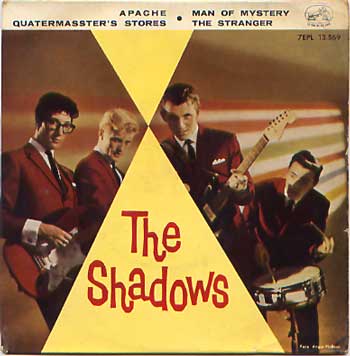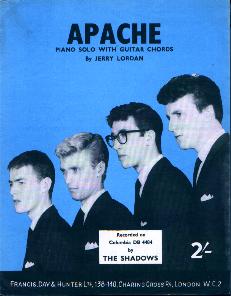| Notes and Quotes: "Apache" |
  |
| Jerry Lordan: ...I found
out to my horror that mine was scheduled to be the B side. They've only
got three hours and they spent two hours fifteen minutes on the A side,
which was ... good, but not as good as mine. I knew that. So then I had
to sit on my hands for ten minutes while there was a break for tea. We
came back, we had forty minutes left, then it was just pure magic, pure
magic. It did not take many takes, three or four, in two tracks only.
(Geddes 1999) |
| Jerry Lordan: ...we
wanted some Indian drums. Tony Meehan couldn't, with only two tracks,
and Hank and the others playing on the other track, Tony ... couldn't
play the regular bass drum, the snare and the tom tom and this Indian
drum, which they didn't have anyway, so Norrie Paramor, the producer,
said go and have a look, lads, in the prop room. This is Studio Two at
Abbey Road, so there's a huge props room under the stairs stuffed full
of ... cow bells and you name it, and they came out with this Chinese
drum. It's actually called a tam tam, and it's circular with a rope on
it, and you hold it in one hand and beat with a mallet with the other,
and Cliff Richard held that over Tony Meehan's drum kit... That's him
all the way through, bom bom bom bom, bom bom... he kept great time, too.
(Geddes 1999) |
|
| Although many examples of
non-vocal popular music borrow directly from the vocal repertoire, Jerry
Lordan's "Apache" takes vocal genres as only a distant reference. In addition
to the music that opens and closes the recording, three principal musical
ideas dominate. |
| The longest (B) is relatively
simple and functions as the basis for variations. The internal organization
of this theme is in a variation on song form (AABA). That is, this section
has four sub-components. However, all four are either the same melody
or a variation on this melody. The first two statements of the melody
are at the tonic level (A minor). The next statement is the same idea
but at a higher pitch level (up four steps to D major), and the last statement
is back at the same level as the first two times. In harmonic terms, this
is a simple i-IV-i progression. The problem is, it is not very harmonically
satisfying. |
| The shortest (C) functions
as a transition, although it fulfills this role largely by being a buffer
between sections. Harmonically, it too lacks a sense of completion (with
a VI-i, VI-i). The rhythm may echo the "horse hooves" rhythm of Frankie
Laine's "Rawhide" that had been a hit (UK #6) in November of the previous
year (1959). |
| The other major musical material
(D) is curious in that it seems incomplete. Immediately, shifting clearly
to a light rock beat and an arpeggiated melody, the music contrasts with
the other melodies. The first statement of the main melody has an ending
that feels incomplete (mostly for harmonic reasons). Following the progression
VI > VII > III > i, the passage almost sounds like the music
has finally found a home key: C major. The second statement ends with
a feeling of semi-closure, landing on a C major chord, but adding a seventh
to make it go back to F. The third time is like the first time. Thus,
this section has three eight-measure phrases, each of which feels harmonically
incomplete. |
| The harmonic surprise of this
song is that for music that is supposed to be in A minor, there is no
dominant. That is, in harmonic music the home chord is defined by the
chord built on a note either five steps up or four steps down: the dominant.
In this song, there is no E major chord, thus no strong definition to
A minor, and thus a sense that the song never harmonically arrives anywhere.
The song's harmonic materials leave the listener as restless as the composer
supposes the subject of the song to be. |
| The performance is partially
in what could be called an arch form. At the peak of this arch is the
sequence of sections B - C - D - C - B. The arch is extended by repeating
the D and C sections and then ending with the same material with which
the recording began. |
| This British dream of the
American west also formed part of the Beatles repertoire in the early 1960s. |
| |
| YouTube mimed performance. |
|
| Schedule |
3 November, 2015
|

